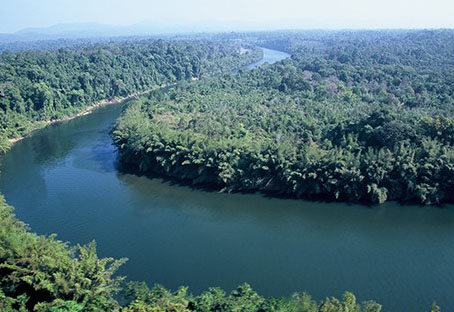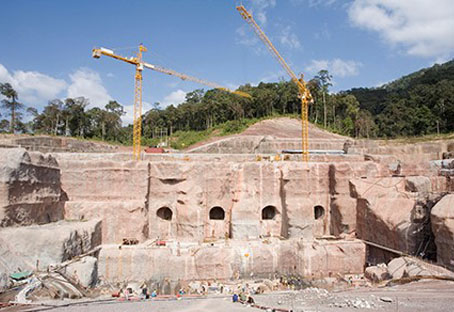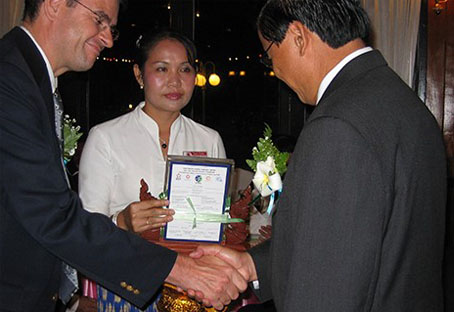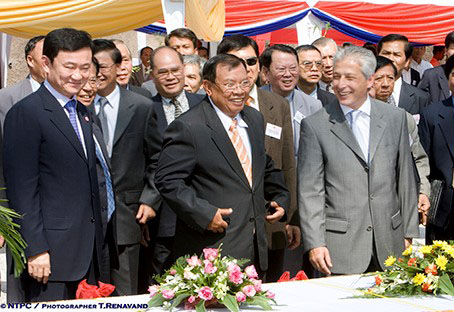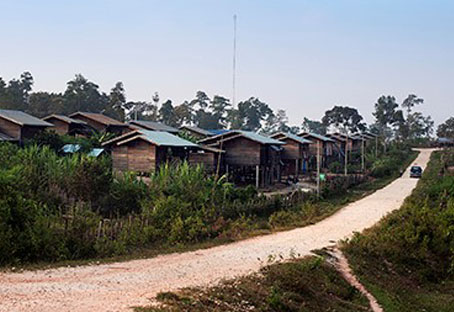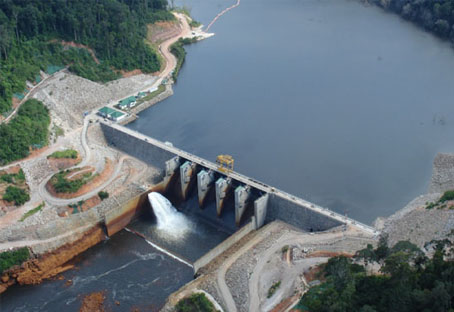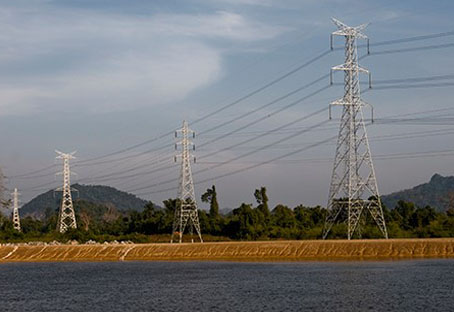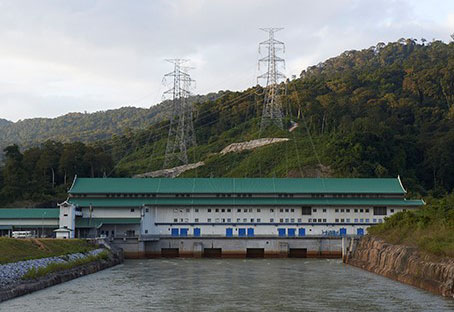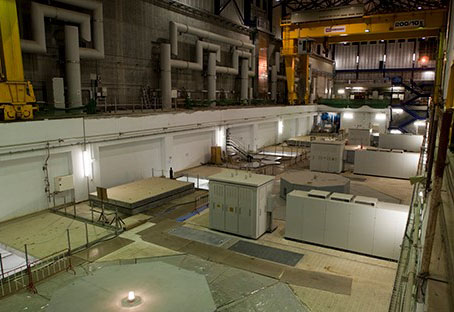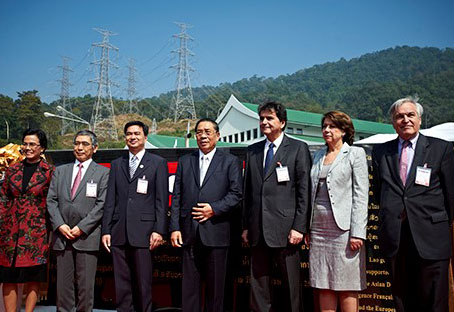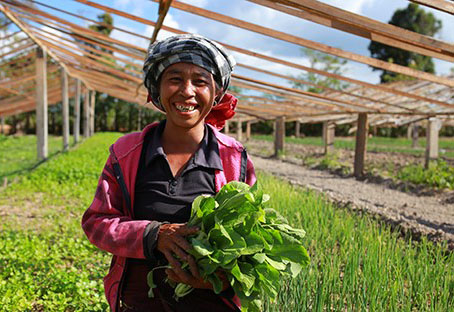The Nam Theun 2 Power Company (NTPC)
Project in Brief
At a Glance Glance
The Nam Theun 2 Power Company (NTPC) is an industrial and development investment owned by two private shareholders and the Lao Government,
backed by commercial lenders and international financial institutions including the World Bank and the Asian Development Bank.
It is described by the Lao Government as “an essential part of the country’s development framework” that “is likely to provide the
first real possibility for Laos to gradually reduce its dependence on Official Development Assistance”. The Nam Theun 2 Hydroelectric Plant began producing electricity commercially in 2010 after almost two decades of planning and construction activities. The Power station has an installed capacity of 1,070 MW that can generate 6000 Gwh of electricity per year. About 95% of the power is exported to Thailand.
Nam Theun 2 has been designed to incorporate a complete set of economic, environmental and social programmes to mitigate its effects on local people and ecosystems, and to improve living standards in the areas over entire Project area. These programmes cover catchment, reservoir and downstream areas, and have been designed in consultation with local villagers, under international guidelines and recommendations from various international financial institutions.
NTPC is a key company for Lao PDR development and is expected to generate 2 billion US$ in government revenue over the 25 year concession period.
1. Project Location.
The Project’s location is very favourable for a large hydroelectric power facility.The natural geography of the Nakai Plateau and the surrounding area is unique in
that it allows a hydroelectric project with a significant head of water without a corresponding requirement fora high dam.
NAM THEUN2 LOCATION
2. Project History.
The potential of the Nam Theun River on the Nakai Plateau for hydroelectric power was identified as early as 1927, but it was not until the mid-1970s that detailed studies of the feasibility of a project began. In the late 1980s the Lao government targeted Nam Theun 2 as a key vehicle for the economic and social development of the nation, and invited the World Bank to participate in the Project. The government and various private investors set up a company and named "Nam Theun 2 Electricity Consortium (NTEC)" to research and develop the scheme. In 1994 Electricité de France and the Italian-Thai Development Company of Thailand joined the Project, and Nam Theun 2 moved from a conceptual to a development phase. The design and preparation of a complete set of economic, environmental and social safeguards took more than ten years, during which time NTEC became the Nam Theun 2 Power Company Limited, or NTPC. Project financing was gradually put in place and full construction activities commenced in June 2005.Nam Theun river potential
Shareholders
Electricité de France (40%) | Project shareholder (EDF International), Head Contractor In addition to supplying financial backing and coordinating construction of the Project, EDF also supplies technical services and personnel management to NTPC. An energy market leader in Europe, the EDF Group is an integrated energy company operating in all branches of the industry: generation, transmission, distribution, and the trading and sale of energy. http://www.edf.com
Lao Holding State Enterprise (25%) | Project shareholder Lao Holding State Enterprise (LHSE) is a state-owned company, established in February 2005 to hold the Lao government’s shares in NTPC. LHSE was created as the entity through which the government’s Nam Theun 2 revenue will pass. LHSE replaced Electricité du Laos (EDL) as the government shareholder in NTPC. www.laoholding.com
Electricity Generating Public Company Limited (35%) | Project sponsor and shareholder, technical services and personnel management provider (through its ESCO subsidiary) EGCO was established in 1992 in accordance with the Thai government’s privatisation policy for the energy sector. The first independent power producer in Thailand, EGCO was created to acquire some of the assets of EGAT and to supply generating capacity and electrical energy to EGAT under long-term power purchase agreements. www.egco.co.th Financing
A total finance package worth US$1,580 million in capital commitments to NTPC was completed in May 2005. This funds the total base Project cost of $1,250 million, plus additional amounts for contingency and ancillary bonding facilities.
The financing arrangements reflect the Project economics: just as NTPC will receive payment for the electricity it generates in a US dollar/Thai baht split, so its credit is arranged in a half dollar-half baht arrangement. This increases the financial stability of the arrangement.
The US$ senior debt facilities include political risk guarantees from the Asian Development Bank (ADB), the World Bank and the Multilateral Investment Guarantee Agency (MIGA), export credit agency support from COFACE of France, EKN of Sweden and GIEK of Norway, and direct loans from a number of multilateral and bilateral development agencies including the ADB, Nordic Investment Bank, Agence Française de Développement (AFD), PROPARCO and the Export-Import Bank of Thailand.
Nine international commercial banks (ANZ, BNP Paribas, BOTM, Calyon, Fortis Bank, ING, KBC, SG and Standard Chartered) and seven Thai commercial banks (Bangkok Bank, Bank of Ayudhya, Kasikornbank, Krung Thai Bank, Siam City Bank, Siam Commercial Bank and Thai Military Bank) are providing long term loans to NTPC.
In addition to senior loans facilities, shareholders complete the Project financing by contributing equity pro-rata their respective participation in NTPC. The equity contribution of LHSE is financed by means of loans, grants and other financing from institutions including the AFD, ADB, European Investment Bank and the World Bank.
External links to International Financial Institutions:
• World Bank: www.worldbank.org
• Asian Development Bank: www.adb.org
• Agence Francaise de Developpement: www.afd.fr
• European Investment Bank: www.eib.org
4. Technical Information
Specifications:
• a 39-m high, 436-m long, concrete gravity dam with integrated spillway;
• a 450-km2 reservoir (at Full Supply Level) with active storage of 3,530 million m3;
• a catchment area of 4,039 km2;
• an average net head of water of 348 m;
• a Power Station comprising 4 x 250 MW Francis turbines (for supply of power to EGAT) and 2 x 37.5 MW Pelton turbines (for supply of power to EDL);
• a double-circuit 115 kV transmission line to Mahaxai in Laos;
• a 138-km long double-circuit 500 kV transmission line to the Thai border; and
• a 160-km long double-circuit 500 kV Transmission Line from the Thai border to Roi Et (built and funded by
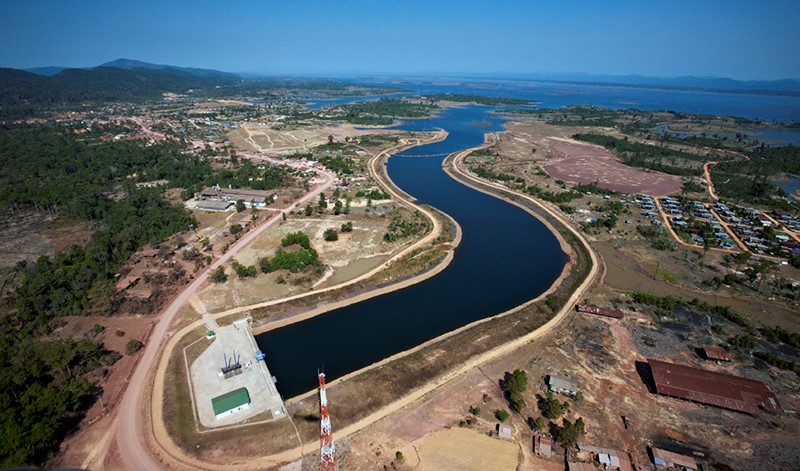
Hydrology
The flows of the Nam Theun River have been measured, either directly or indirectly, since 1950 and records show an average flow of 7.5 billion cubic metres of water each year.
The reservoir capacity is 3.9 billion m3 and, based on the long-term average, could be filled easily in the wet season. Indeed, based on the statistics available, the water flows of the Nam Theun were greater than the reservoir’s total capacity in 49 out of the 50 years since records began, meaning that the water flows of the Nam Theun would have filled the reservoir’s “live capacity” (i.e. the water volume that can be used for generating purposes) in just one year.
Such statistics allowed the project partners to design and develop the NT2 scheme, and to confidently negotiate a long-term Power Purchase Agreement (PPA). Nevertheless, as the ability of NTPC to supply energy to EGAT depends on, inter alia, hydrological conditions, the PPA incorporates a mechanism that stabilises the Company’s cash flow by dampening the effects of hydrological variation from one year to the other.
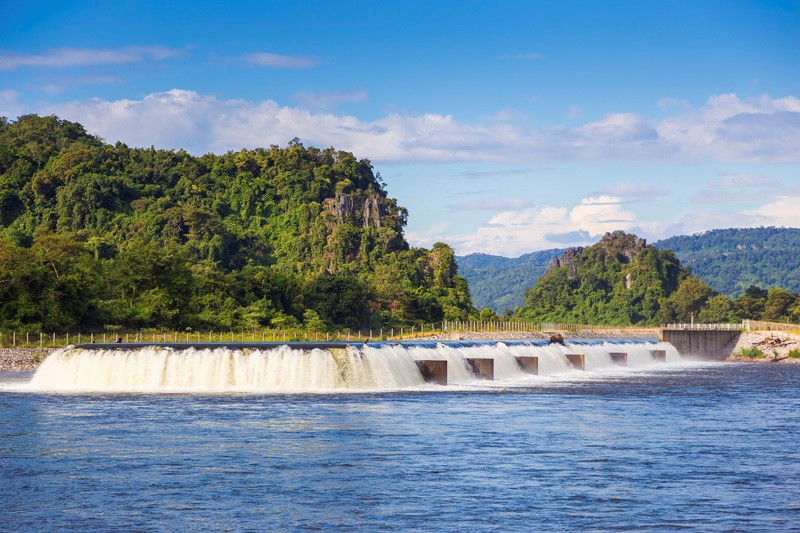
Dam & Reservoir
The Project reservoir has inundated 40% of the Nakai Plateau by creating a shallow reservoir (on average 7 m deep) with a surface area of 450 km2 at full supply level. This will reduce in size to a surface area of a little as 70 km2 at the end of the dry season.
The reservoir has been formed by construction of a 39-m high gravity dam with a crest length of 325 m across the Nam Theun, plus 13 small earthwork saddle dams along the west bank of the reservoir. A spillway and stilling basin have been specially designed for the purpose of reservoir level control.
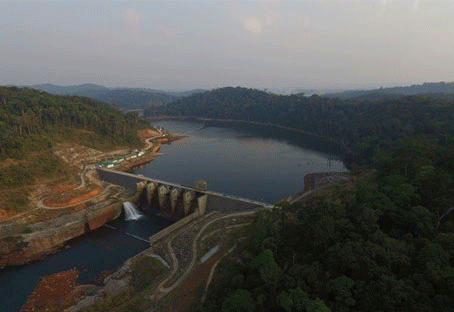
Waterways
A 5-km long headrace channel has been excavated in the reservoir floor to direct the stored water to the intake structure. Three kilometres of headrace tunnel, pressure shaft and pressure tunnel transport water from the intake structure to the power station. After passing through the turbines the water enters the Regulating Pond, which has a live storage capacity of 8 million m3, allowing the Project to control releases of water back into the natural river system. The Regulating Dam releases water into a 27-km man-made Downstream Channel, which carries its flow to the Xe Bang Fai River.

Power Station
The Power Station is located at the foot of the escarpment of the Nakai Plateau in the Nam Kathang Valley. To fit with the EGAT requirement for intermediate peaking power, the Power Station is equipped with four 250 MW Francis Unit turbines that can provide EGAT with 995 MW or 5,636 GWh of electricity per year. In addition, two 43 MW (nominal rating) Pelton Units can provide EDL with 75 MW or 300 GWh of electricity per year, and cover Internal power station needs

Transmission Lines
Both the seller (NTPC) and the main buyer (EGAT) have built transmission lines on their own sides of the Lao-Thai border for delivery at the border. Accordingly, electricity generated at the power station for EGAT is delivered to the border near Savannakhet via a 138-km double-circuit 500 kV transmission line constructed by the Project. EGAT has constructed a 160-km 500 kV line from the border to its substation at Roi Et in north-east Thailand. The electricity delivered at the power station for EDL is transmitted to Thakhek via a 70-km long 115 kV transmission line. EDL will also take up to 15 MW of energy from the power station switchyard via 22 kV lines to the resettlement villages.

Electricity sales to EGAT and EDL
| Period | EGAT(GWh)1 | EDL(GWh)2 | Total(GWh)3=1+2 |
|---|---|---|---|
| Plan 2022 | 5,485 | 220 | 5,705 |
| Percentage(%) | 70.40% | 97.25% | 71% |
| 01/2022 | 490.60 | 10.20 | 500.80 |
| 02/2022 | 423.20 | 12.72 | 435.92 |
| 03/2022 | 515.00 | 33.12 | 548.12 |
| QuarterI | 1,428.80 | 56.04 | 1,484.84 |
| 04/2022 | 363.40 | 30.90 | 394.30 |
| 05/2022 | 367.10 | 30.45 | 397.55 |
| 06/2022 | 404.92 | 29.34 | 434.26 |
| QuarterII | 1,135.42 | 90.69 | 1,226.11 |
| 07/2022 | 639.05 | 31.19 | 670.24 |
| 08/2022 | 404.13 | 17.51 | 421.64 |
| 09/2022 | 256.73 | 18.53 | 275.25 |
| QuarterIII | 1,299.91 | 67.23 | 1,367.13 |
| 10/2022 | 167.40 | 15.79 | 183.19 |
| 11/2022 | 139.24 | 13.34 | 152.58 |
| 12/2022 | - | 12.31 | 12.31 |
| QuarterIV | 306.64 | 41.44 | 348.08 |
| TOTAL2023 | 837.70 | 76.32 | 914.02 |
| Plan 2023 | 4,304 | 220 | 4,524 |
| Percentage | 19% | 35% | 20% |
| 01/2023 | 198.1 | 13.5 | 211.6 |
| 02/2023 | 207.6 | 10.15 | 217.75 |
| 03/2023 | 204.5 | 24.17 | 228.67 |
| QuarterI | 610.20 | 47.82 | 658.02 |
| 04/2023 | 227.5 | 28.5 | 256.00 |
| 05/2023 | 228.7 | 22.97 | 251.67 |
| 06/2023 | 226.39 | 19.94 | 246.33 |
| QuarterII | 682.59 | 71.41 | 754.00 |
| 07/2023 | 402.8 | 18.34 | 421.14 |
| 08/2023 | 422.95 | 19.9 | 422.85 |
| 09/2023 | 550.67 | 37.28 | 587.95 |
| QuarterIII | 1,376.42 | 75.52 | 1,451.94 |

